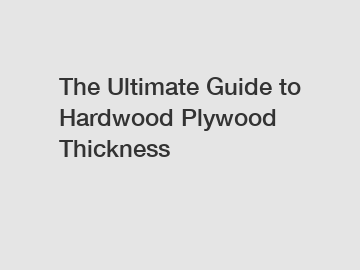The Ultimate Guide to Hardwood Plywood Thickness
When it comes to selecting the perfect hardwood plywood for your project, there are a multitude of factors to consider. One of the most critical elements is the thickness of the plywood. Choosing the appropriate thickness not only ensures structural integrity but also determines the overall performance and longevity of your finished piece. In this comprehensive guide, we will dive into the world of hardwood plywood thicknesses to help you make an informed decision and achieve stellar results.
1. Understanding the Basics:
Hardwood plywood thickness is measured in fractions of an inch and typically ranges from 1/8" to 1 1/4". It's important to note that the nominal thickness may differ slightly from the actual thickness due to manufacturing processes. Plywood is composed of multiple layers, or "plies," that are glued together, resulting in a durable and sturdy panel. The thickness of these plies and the number of layers determine the overall thickness of the plywood.

2. Factors to Consider:
a. Application:
The first step in choosing the right thickness is understanding the intended use of the plywood. Different applications require varying degrees of strength and stability. For instance, projects like cabinet doors or decorative panels may call for thinner plywood, while load-bearing structures like shelving units or furniture frames require thicker boards for added support.
b. Span and Support:
The size of your project and the span it needs to cover should also influence your choice of plywood thickness. Larger surfaces prone to sagging or flexing, such as tabletops or countertops, demand thicker plywood to ensure they can bear the weight without any structural compromise. Consider the support structure beneath the plywood and the expected load it will carry.
c. Design Criteria:
The design and aesthetics of your project may also dictate the thickness you should opt for. Thicker plywood panels offer more depth and presence, complementing heavy or rustic designs. Conversely, thinner panels provide a sleek and modern appearance ideal for contemporary styles. Carefully consider your project's overall vision and balance it with functional requirements.
3. Standard Thicknesses and Their Applications:
a. 1/8" and 1/4" Plywood:
These thin plywood panels are commonly used for interior applications, such as wall paneling or backing for cabinets. They are suitable for projects where weight is a concern, and structural support is not critical. The flexibility of these thicknesses allows for easy shaping and bending, making them popular for curved surfaces or trim work.
b. 1/2" and 3/4" Plywood:
These thicker plywood options provide enhanced strength and stability, making them excellent choices for load-bearing applications. 1/2" plywood is commonly used for cabinet construction and shelving units, while 3/4" is recommended for furniture frames, countertops, and heavy-duty projects.
c. 1" and 1 1/4" Plywood:
These thicker varieties are typically used in specialized applications that require exceptional strength, such as industrial structures or high-traffic flooring. Though less commonly found and often more expensive, their immense durability makes them indispensable for projects subjected to extreme wear and tear.
4. Additional Considerations:
a. Cost and Availability:
While thicker plywood generally offers increased strength, it is also costlier than thinner options. Balancing your budget and the demands of your project is crucial, as thicker plywood may not always be necessary. Additionally, availability may vary depending on the region, so research local suppliers and their product offerings.
b. Surface Finish:
The thickness you choose will influence the finishing process. Thinner panels may require extra care during sanding and finishing to avoid sanding through the veneer, while thicker plywood allows for deeper sanding and potentially refinishing in the future.
Conclusion:
Selecting the appropriate hardwood plywood thickness is essential for any successful woodworking endeavor. By considering factors such as application, support requirements, and design criteria, you can confidently choose the ideal thickness that aligns with your project's specific needs. Remember to explore standard thicknesses, be mindful of cost, and factor in the surface finish to achieve outstanding results. With this ultimate guide at your disposal, you're now equipped to make an informed decision and embark on a remarkable woodworking journey. Happy crafting!
If you want to learn more, please visit our website marine plywood specifications, what is birch plywood used for, Film-faced Plywood.
157
0
0

Comments
All Comments (0)